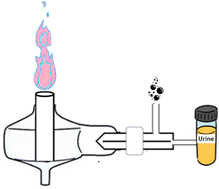Analysis of urine by MIP-OES: challenges and strategies to correct matrix effects†
Abstract
This work investigated the potential of microwave-induced plasma optical emission spectrometry (MIP-OES) for urine analysis using a complex matrix containing carbon and high concentrations of easily ionizable elements (EIEs). The goals were to study interferences originating from the urine matrix for 14 analytes with total energies varying from 1.85 to 12.07 eV, along with strategies to correct matrix effects and compare the results with those reported in the literature using inductively coupled plasma optical emission spectrometry (ICP-OES). It was found that the urine matrix caused suppression of the signals for some elements and increased them for others. Therefore, an internal standardization calibration method and three levels of dilution, i.e., 2-, 20-, and 200-fold, were applied as strategies to correct non-spectral interferences. Also, Ga, Ge, Pd, Rh, Sc and Y and four molecular species present in the nitrogen plasma (i.e., CN, N2, N2+, and OH) were investigated as potential internal standards (ISs). The accuracy and precision were evaluated by addition and recovery experiments and best results were obtained using ISs Ge, Rh and Sc for 20-fold dilution and N2+ for 200-fold dilution. The LODs ranged from 0.33 to 329 μg L−1 and deviations were lower than 11%. The combined use of these strategies led to successful urine analysis for a spiked sample by MIP-OES.

- This article is part of the themed collection: Analytical Methods HOT Articles 2023


 Please wait while we load your content...
Please wait while we load your content...